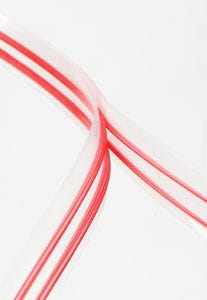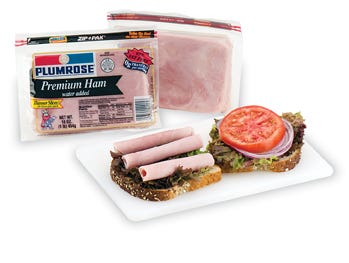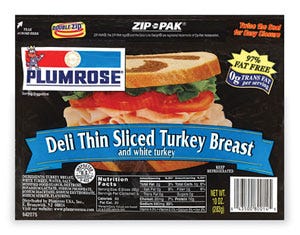January 30, 2014
|
The two-channel design of this closure provides rigidity, which enables nearly automatic alignment when a user seals a package. |
Plumrose USA, East Brunswick, NY, sells a wide range of lunch meats, premium bacons, deli-counter hams, cooked ribs and barbecue products under its three brands—Plumrose, DAK and Danola—in addition to private-label products to both the retail and foodservice markets.
Drivers behind Plumrose's metamorphosis from its beginnings as a sliced ham company in 1932 can be found in the company's mission statement, which emphasizes its charge to sell value-added products using state-of-the-art technology and provide outstanding service while keeping its prices competitive. These efforts have resulted in new products, recipes, manufacturing techniques and packaging alternatives.
History of firsts
Plumrose boasts that it was one of the first manufacturers in the sliced lunch meat industry to offer resealable packaging that used Zip-Pak® (www.zippak.com) closures. The company also vaunts that, in November 2003, it was the first company to introduce a super premium line of deli-style sliced meats packaging with the Zip-Pak Slider™.
Most recently, Plumrose started using Zip-Pak Double Zip™ closures. The new packaging started showing up on store shelves approximately six months ago, as retailers' replenishment needs dictated. As of presstime, 90 percent of the sliced lunch meat products that Plumrose sells are sealed using Zip-Pak Double Zip closures.
Nationwide production
|
Plumrose has production facilities and offices across the country, with three major meat processing plants primarily producing the bacon and lunch meats. The plant in Council Bluffs, IA, is a hog- processing plant that produces deli meats and bacon; the processing facility in Elkhart, IN, is a bacon-slicing plant; and the Booneville, MS, plant is a lunch meat slicing facility.
With 20 slicing lines in the Mississippi location, it is responsible for putting out premium lunch meat varieties including ham, turkey, roast beef and chicken. The different product lines can be identified by the shape that the meat is cut into. The Double Zip is being used for the company's premium 46-in. and D-shape lines.
Nearly automatic alignment
|
To help market its deli meats as premium products, Plumrose displays messenging about the closure at the top of the pack. |
|
When Plumrose executive vp Mike Rozzano was first introduced to the Double Zip, he already was familiar with similar closures, because they are available in the marketplace as part of a retail storage bag for consumers. Rozzano knew the Double Zip would help Plumrose reach two goals: The closure would help the brand differentiate its products from its competition, and the zipper would make Plumrose packaging more convenient for consumers than the packs with a single zipper closure.
“I think the Double Zip is a great improvement over the regular, single zipper closure because it's so much easier to close,” says Rozzano. “It's kind of amazing how your fingers just naturally positioned themselves between the two zippers and they align themselves perfectly every time and it just automatically closes.”
Explaining why the Double Zip is so much easier to close, Zip-Pak director of international sales and marketing Robert E. Hogan comments, “One of the most historical problems with the single zipper is getting aligned properly. The bigger the package, the more potential there was from misalignment. The Double Zip tends to create a natural self-aligning feature that just makes it much easier to reseal with your fingers.”
The results of consumer focus groups conducted by the closure manufacturer found that the Double Zip's ease of operation appears to cut across all age ranges. “A lot of the young mothers in the group felt like it would be an easier package for the children to close just because it's so intuitive and your two fingers fit right along the profile. So, you know that it's closed,” says Zip-Pak Marketing Manager Elizabeth Sheaffer. “Also for the aging population, it seems to be a much easier package for them to close as well.”
Ready for marketing
According to Zip-Pak, consumer response to the double zipper concept and their perceptions that this type of closure is easier to seal has helped Zip-Pak's customers use the closure to position their products as premium. Certainly Plumrose is using the Double Zip brand to help position its brand.
Plumrose's lunch meat packaging, which is designed by Plumrose's in-house graphics manager Kerry Ann Sander, consists of films from Alcan Packaging (www.alcanpackaging.com) and Curwood, Inc. (www.curwood.com). Alcan Packaging provides the printed films that are used on the front of the packages. This printed film features a Double Zip logo on its tearstrips. The Zip-Pak logo also is placed top and center of the Plumrose packaging.
Minor modifications
While Plumrose dedicated the top and center of its package for the Double Zip move, the company found the changes that needed to be done to its existing packaging lines, which use form/fill/seal machines (f/f/s) from multiple manufacturers, were minimal. The updates went smoothly, partly due to the consulting done by closure manufacturer.
As part of Zip-Pak's systems business, the company offers consulting and on how to do these types of retrofits. “Even though the resealable packages are quite common, it still is technology that they don't necessarily teach at Michigan State packaging school,” Hogan explains. “So resealable packaging is something that I wouldn't say is unique, but I would say is specialized.”
To help its customers more easily retrofit their existing f/f/s machines, Zip-Pak will be introducing a retrofit solution at this year's PACK EXPO Intl.. The zipper applicator is designed to apply the resealable closure in the transverse or cross-web direction, across the top of a package. The retrofit system will be applying the Double Zip closure at the show.
Working together, Plumrose and Zip-Pak identified that only minor modifications were needed to retrofit the food processor's f/f/s machines. These upgrades were made to the machines' seal bars, which apply zippers when closing a package.
Brand-building features
While the Double Zip technology benefits end-consumers the most with its ability to create enough rigidity in flexible film packaging to enable virtually automatic alignment of the two interlocking profiles, the resealable closure has been enjoying positive feedback from Plumrose customers. They say that the move has reinforced their perceptions that Plumrose always is trying to be at the forefront of innovations, whether these innovations are for its products or packaging.
Retailers who also have their private-label lunch meat brands sliced and packaged by Plumrose are especially excited at the opportunity to use the new closure to build their brands, says Rozzano.
In this competitive market, Plumrose is using Double Zip to maintain its current business and protect its products. As Rozzano is quick to mention, the product is what sells the experience to its customers and the ultimate consumers. “Having packaging improvements like this, just adds another dynamic to it,” he explains.
More information is available: |
Zip-Pak, 800/488-693. www.zippak.com. |
Alcan Packaging, 773/399-3683 www.alcanpackaging.com. |
Curwood, Inc., 920/303-7300. www.curwood.com. |
About the Author(s)
You May Also Like






